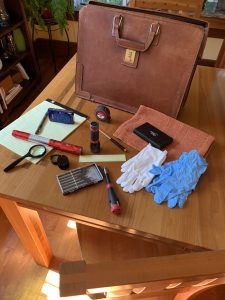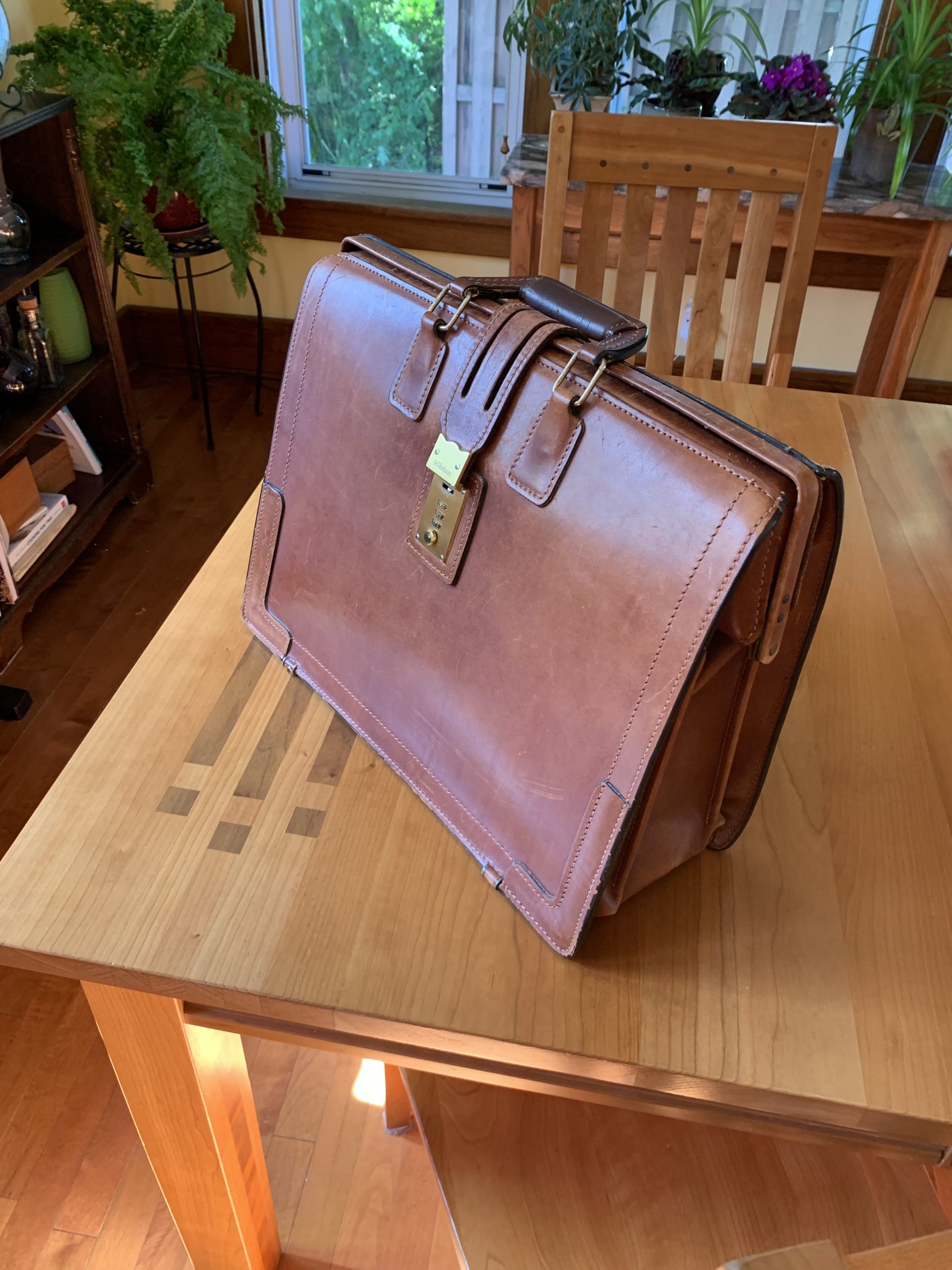A certified appraisal must include a physical inspection of the property. Photographs alone only scratch the surface of an object; they can’t be trusted to capture any literal scratches there may be on its surface . . . or whether the thing works or has all its parts or the finer points of its manufacture and age, all matters that really matter when determining an opinion of value that will be accepted by the IRS, courts, and insurance companies. For those purposes, an in-person, inch-by-inch going over is required. That means that the appraiser must arrive at the residence or storage unit or barn equipped with all the tools that she could possibly need to complete a thorough inspection, sometimes under less than ideal conditions, like low light or excessive dust.
When I go to an on-site inspection, I carry a “toolbox” packed with everything I could need for almost any kind of antiques contingency. Here are the critical tools of my trade:
- Flashlights. Nothing is as useful for inspection as a good light source. My bright LED flashlight has a goose-neck extension that allows me to see around corners and really get into tight spaces. I also need a
 UV flashlight, aka “black light.” This little number is essential for detecting things the naked eye can’t. It illuminates hairline cracks on teacups, uranium in Depression glass, authentic old paint on cast iron, and it even helps me distinguish between ivory, bone, modern plastic, and Bakelite.
UV flashlight, aka “black light.” This little number is essential for detecting things the naked eye can’t. It illuminates hairline cracks on teacups, uranium in Depression glass, authentic old paint on cast iron, and it even helps me distinguish between ivory, bone, modern plastic, and Bakelite. - Screwdrivers. I need quite a variety of these, so I carry a Phillips head (invented in the 1930s, this type of screw is a sure sign of reproduction or modern repair), a flat head, and a set of precision screwdrivers for clock mechanisms and other teeny weeny stuff.
- Gloves. Gloves protect both me and the thing I’m touching. Sometimes, like the day I stumbled upon a mummified mouse, I’m more concerned about me than the thing, quite frankly. I prefer nitrile gloves over latex or rubber because they are easier to get on, especially in hot conditions, and the rubber types are more likely to react with the surface of the thing I’m touching. For silver, white cotton gloves are really best. But I’m not that big of a snoot as to never touch an artifact with my bare hands. A silver tea set was made to be handled, after all, but some things really do need to be treated with kid gloves, so to speak.
- A pointer. I keep an attractive chopstick in my case, just in case I need to point out something small or detailed to an owner, like damage or a maker’s mark they never noticed before. A pointer really comes in handy when I need to call attention to something broken. The less it’s handled, the better, and my chopstick keeps me at a safe distance when it’s needed.
- A pad and pen. I give the owner generous time to tell their story about their object and I prefer to take notes on paper rather than by recorder or a keyboard. Folks are often intimidated by voice recording and typing looks like I’m not paying attention. Manual notetaking is a way I can show intensity of listening to them, which in itself encourages the narrator to go on. Appraising is as much about understanding human beings as about understanding the things themselves. At least the way I do it. I also take detailed notes on the physical characteristics of the object: dimensions, damage, marks and labels, model numbers, etc.
- A tape measure and ruler. I measure everything; it’s like a compulsion: furniture, saucers, clock faces, spoons. A lamp, for instance, may have been available in three sizes: 15″, 17″, and 20″. A photograph alone of a single example in isolation won’t help to distinguish one model from another. Perhaps the jumbo size was produced in very small numbers for just a year or two, but the middle size was sold in bunches for decades. Size in that case will greatly affect value.
- Magnifiers. I like to use an old-fashioned magnifying glass for some things. Mine is an 8x, but for silver marks, jewelry, even the cellular structure of wood, I need super powers. For that I have a loupe that allows me to go up to 15x magnification in 5x increments. Very versatile.
- A digital camera. Photographs are indispensable in my reporting procedures. I find a point-and-shoot Canon is more than sufficient. It’s small and not too expensive, tough and not fussy. I need a camera with pretty good zoom and wi-fi for dumping to my computer. My little Canon ELPH 190 is ideal. In some ways, the photographic record is more for me and future appraisers than for the owner in that the pictures document the specific object at a specific moment in time for comparison in the future. They also help me visualize the material reality of the object as I’m writing my narrative description of it, sometimes a couple of weeks after actually seeing it in person.
- A scale. I am a silver specialist and silver is a precious metal commodity that always has material value in itself. The scale allows me to estimate on the spot what the value of a sterling silver item might be irrespective of its design, function, maker, and other characteristics. Now, true, I can’t weigh a massive punch bowl on this thing, but it’s good for finding the average weight of a spoon in your grandmother’s flatware service for 12. Knowing the weight of the silver alone helps me calculate and contextualize its value to an owner who might just want to melt it, for instance.
- A mat. I keep a small mat in my bag for those situations when I don’t have a clean or soft surface to place something on while I’m going over it. It’s just an ordinary placemat I picked up at Pier I, but it’s a useful tool for treating even the most humble object with the degree of respect it deserves.
So that’s it. A professional antiques appraiser, like a good Scout, is always prepared!

